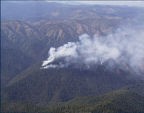 |
|
|||
| "From this mountain I could observe high rugged mountains in every direction as far as I could see." | ||||
|
William
Clark, September 15, 1805
|

Welcome!
Part
of Idaho's Big Wild, the Clearwater National Forest covers 1.8 million
acres from the jagged peaks of the Bitterroot Mountains in the east to the
river canyons and the rolling hills of the Palouse Prairie in the west.
The
North Fork of the Clearwater and the Lochsa rivers provide miles of tumbling
white water interspersed with quiet pools for migratory and resident fish.
The mountains provide habitat for elk, moose, whitetail and mule deer, black
bear, gray wolf, cougar, mountain goats, and many smaller mammals.
The ridges between the deep canyons have provided travel corridors across
the mountains for centuries. These routes were used by the Nez Perce Indians
and, in 1805-1806, the Lewis and Clark Expedition. Today the main travel route
is U.S. Highway 12 following the dramatic canyon of the Middle Fork of the
Clearwater River and its tributary the Lochsa River.
|
Three-Pronged
Strategy That's
what Clearwater Forest Supervisor Larry Dawson shares with those who
say they oppose using fire as a management tool. "These Forests
and their inhabitants were born of, then shaped by fire."
"To address 60 years of fire suppression and to reintroduce natural processes to the landscape, the Clearwater National Forest has implemented the Three-Pronged Strategy. The strategy includes logging in the "roaded front," prescribed burning in the unroaded back country; and managing lightning strikes for beneficial uses where it is ecologically sound to do so. |
![]()
 |
|
 |
In
1805 Lewis and Clark followed
the Lolo Trail through the mountains of Idaho and Montana. This rugged
path had been carved over the centuries by indigenous peoples traveling
to hunting areas and to trade with neighboring tribes. Known locally
as the "Lolo Motorway," the Lolo Trail National Historic Landmark
is still traveled by adventurous explorers and is still sacred to the
Ni Mii Puu (Nez Perce Indians).
|
| "A
fair morning. Cold. I proceeded on in advance with six hunters. Made 32
miles, encamped on a bold running creek passing to the left, which I call
Hungry Creek, as at that place we had nothing to eat." Meriwether Lewis Sept 18, 1805 |
 |
![]()
|
|
"From this place we had an extensive view of these stupendous mountains . . . . we were entirely surrounded by those mountains from which to one unacquainted with them it would have seemed impossible ever to have escaped." |
|
Meriwether
Lewis, June 27, 1806
|
|
Comments
on this site?
EMail the Webmaster |
||
|
|
||
|
|
||
|
Updated Sept 30, 2004 |
|
|
|
|
||
|
11.1.00 |
||






